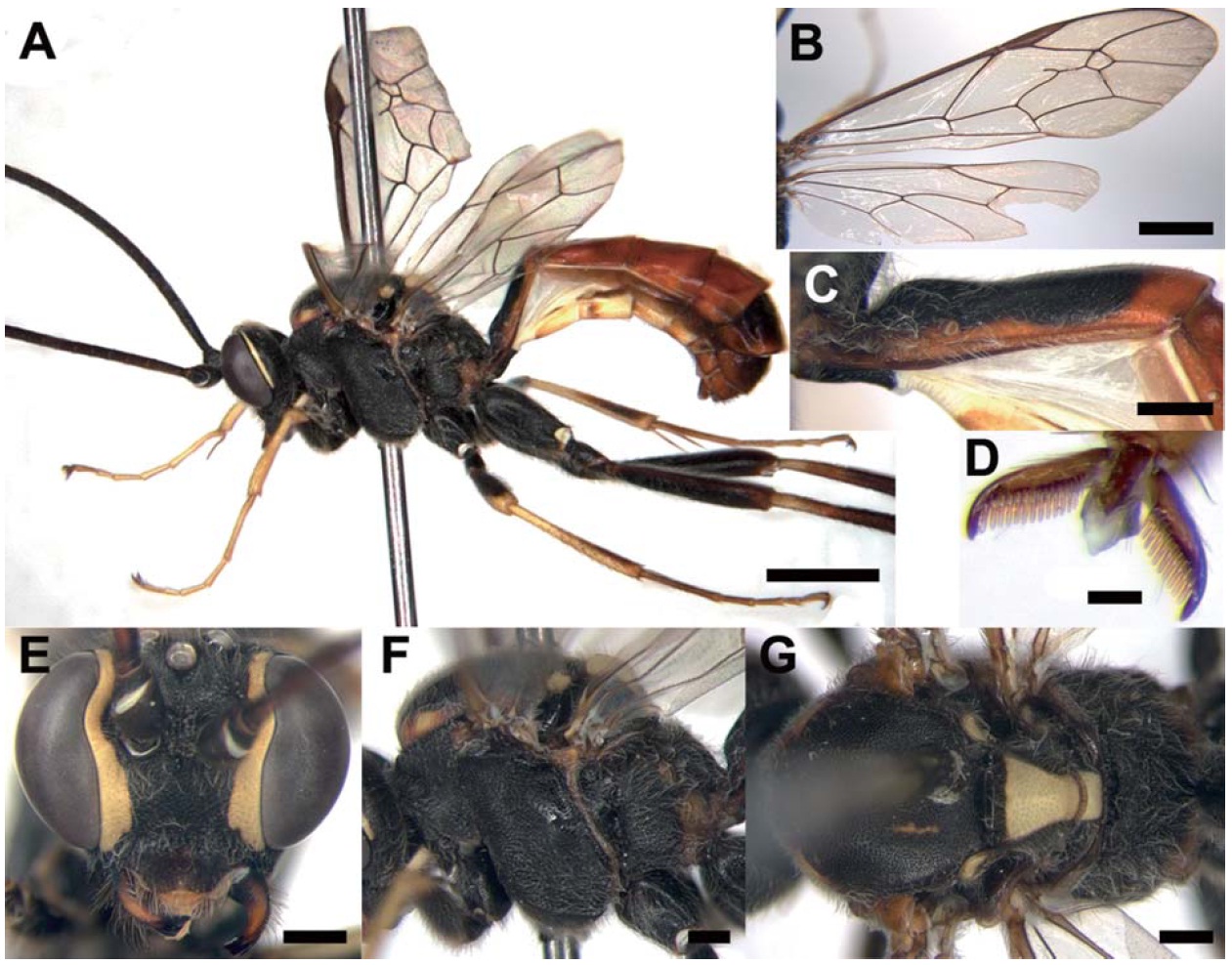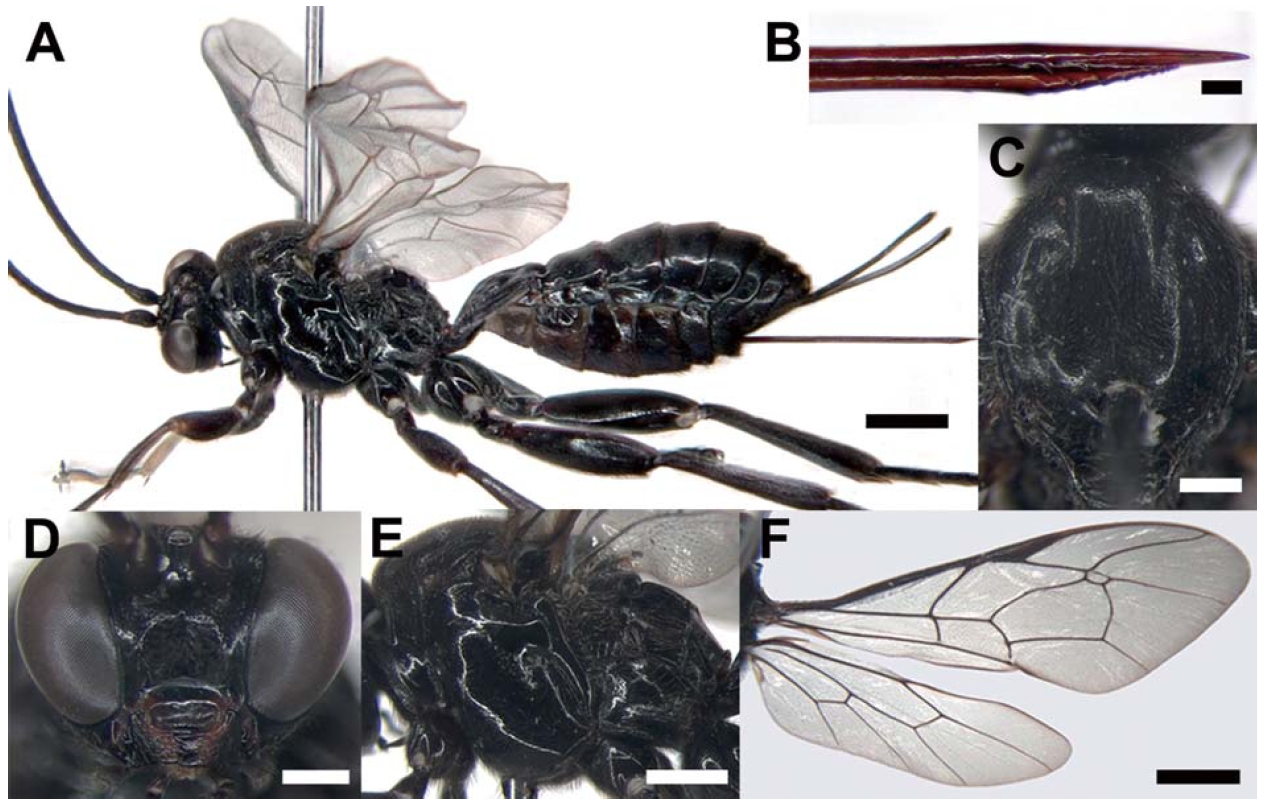



The subfamilies, Banchinae Wesmael, 1845 and Pimplinae Wesmael, 1845 are large-sized groups belonging to the Family Ichneumnidae. The Banchinae includes 1,758 species of 65 genera and Pimplinae includes 1,686 species of 78 genera around the world (Yu et al., 2012).
The Genus
The another genus treated herein
In the present study two unrecorded species,
The morphological terminologies follow those of Townes (1969) and Yu et al. (2012). Photographs were taken using an AxioCam MRc5 camera attached to a stereomicroscope (Stemi SV 11 Apo; Carl Zeiss, Gottingen, Germany), processed using AxioVision40AC software (Carl Zeiss), and optimized with an i-delta imaging system (i-Delta 2.6; iMTechnology, Daejeon, Korea).
All specimens used were deposited at the Yeungnam University, South Korea (YNUE). Abbreviations for the type information, collecting method and the province of collection localities are as follows: TL, type locality; TS, type species; MT, malaise trap; CB, Chungcheongbuk-do; CN, Chungcheongnam- do; DG, Daegu-si; DJ, Daejeon-si; GB, Gyeongsangbuk- do; GG, Gyeonggi-do; GJ, Gwangju-si; GN, Gyeongsangnam- do; GW, Gangwon-do; JB, Jeollabuk-do; JJ, Jejudo; JN, Jeollanam-do; SU, Seoul-si; US, Ulsan-si.
Order Hymenoptera
Family Ichneumonidae Latreille, 1802
Subfamily Banchinae Wesmael, 1845
1*Genus Rynchobanchus Kriechbaumer, 1894
2*Rynchobanchus minomensis (Uchida, 1933) (Fig. 1)
Material examined. Korea: 1♂, CB: Cheondong-ri, Mt. Sobaek, 12 May 1994, Kim JG; 2♂♂, Dannyang-gun, Cheondong-ri, 11 May 1994, Cho OH; 1♂, ditto, 14 May 1994, Park HY; 1♂, Dannyang-gun, Dannyang-eup, Mt. Sobaek, 11 May 1994, Kim TD; 1♀2♂♂, ditto, 23 May 1997, Lee JW; 3♂♂, ditto, 12 May 1994, Jang JH; 4♂♂, ditto, Kim JI; 2♂♂, ditto, 13 May 1994, Lee MK; 28♂♂, ditto, 12 May 1994, ?; 3♂♂, ditto, Choi AJ; 3♂♂, ditto, Jang JH; 3♂♂, ditto, Kim JI; 4♂♂, ditto, Seo MJ; 2♀♀, ditto, Lee MK; 3♂♂, ditto, Kim TS; 3♂♂, Goesan-gun, Cheongcheon-myeon, Mureung-ri, 22 Apr 2006, Oh SH; 1♀3♂♂, CN: Cheonan-si, Dongnam-gu, Gwangdeokmyeon, Gwangdeok-ri, 22 Apr 1984, Lee JW; 1♂, Gongjusi, Gyeryong-myeon, Jungjang-ri, Mt. Gyeryong, Gapsa, 24 Apr 1983, Park HC; 1♂, DG: Dalseo-gu, Songhyeon-dong, Mt. Daedeok, 11 May 1992, Kim KM; 3♂♂, DJ: Dong-gu, Secheon-dong, 20 May 1996, No MS; 1♀, GW: Hongcheongun, Nae-myeon, Gachilbong, 24 May 1996, Kim HY; 1♀, ditto, 25 May 1996, Lee KH; 29♂♂, Taebaek-si, Hyeoldong, Mt. Taebaek, 13 May 1991, Lee JW; 30♂♂, Taebaek- si, Mungoksodo-dong, Danggol, 6 May 1999, Lee JW; 1♀, GG: Gapyeong-gun, Buk-myeon, Mt. Myeongji, 21 May 1997, Jang SY; 7♂♂, Seongnam-si, Baramgol, 25 Jun 1984, Lee JW; 2♀♀, Gwacheon-si, Galhyeon-dong, 126-5, 17 Apr 1983, Lee JW; 1♀, GB: Cheongdo-gun, Unmun- myeon, Sinwon-ri, Mt. Unmun, 24 Aug 2008, Lee JW; 5♂♂, Gyeongsan-si, Dae-dong, Yeungnam University, 27 Apr 1996, Kwon OK; 1♀, Miryang-si, Sannae-myeon, Mt. Gaji, 27 Apr 2001, Park ES; 8♂♂, JB: Muju-gun, Seolcheon- myeon, Mt. Deogyu, 4 May 1999, Lee JW; 1♀, JN: Jangseong-gun, Bukha-myeon, Yaksu-ri, 252-1, Mt. Naejang, 26 May 2006, Kwon JM; 1♀2♂♂, SU: Dobong-gu, Dobong- dong, Mt. Dobong, 20 Apr 1983, Jang GS; 1♂, Seocho- gu, Seocho-dong, Mt. Umyeon, 12 May 1990, Shin JE.
Diagnosis. Body 10.9-16.0 mm long, forewing length 10.6- 14.6 mm long. Body black. Palpi, around the compound eye, scutellum, postscutellum, tegula, small subtegular spot, apical parts of fore and mid femur, fore and mid tibia, fore tarsus yellow; ventral part of antenna, teeth of mandible, anterolateral part of mesoscutum, mid and hind dorsal part of femur, mid apical part of tibia, hind tibia, mid and hind tarsus, first metasomal tergite in its posterior one-fifth, 2nd to 8th metasomal tergites yellowish to reddish brown. Clypeus densely punctate with a apicomedian notch. Upper tooth of mandible much wider than lower tooth. Face densely punctate with a projecting small horn between the antennal sockets (Fig. 1E). Distance from the posterior edge of a lateral ocellus to the occipital carina shorter than its maximum diameter. Antenna with 49-56 flagellomeres. Mesosoma entirely densely punctuate (Fig. 1F, G). Notauli very weakly visible. Scutellum strongly convex (Fig. 1F). Propodeum short, not convex and without carinae. Tarsal claws pectinate in its basal three-fourths (Fig. 1D). Nervulus 7.0 times as long as basal vein and 0.8 times ramulus (Fig. 1B).
Host records. Unknown.
Distribution. Korea (new record), China, Japan and Far Eastern Russia.
Subfamily Pimplinae Wesmael, 1845
1*Genus Theronia Holmgren, 1859
Key to the species of Theronia from Korea
1. Body reddish brown with black marks. Notaulices shorter, present in approximately apical one-third of the mesoscutum. Lateral carinae of Areola parallel ???????????????????????????????????????????
- Body predominantly black. Notaulices longer, present in apical half of the mesoscutum. Lateral carinae of Areola divergent ????????2*
Theronia laevigata nigra Uchida, 1928 (Fig. 2)
Material examined. Korea: 3♀♀, CB: Dannyang-gun, Dannyang-eup, Cheondong-ri, Mt. Sobaek, Cheondong valley, 30 Apr-21 May 2007 (MT), Lee JW; 5♀♀, Boeun-gun, Songnisan-myeon, Sanae-ri, Beopjusa, 12-21 Jun 2007 (MT), Lee JW; 1♂, DG: Nam-gu, Bongdeok-dong, Mt. Ap, 1 May 2004, Lee JW; 1♀, DJ: Dong-gu, Yongun-dong, Daejeon Univ., 18 May-14 Jun 2007 (MT), Lee JW; 1♂, GB: Cheongdo- gun, Unmun-myeon, Mt. Unmun, 4-30 May 2009 (MT), Lee JW; 2♂♂, Yeongju-si, Punggi-eup, Jungnyeong, 22 Jun-3 Jul 2009 (MT), Kim CJ; 4♀♀, GG: Gapyeonggun, Cheongpyeong-myeon, Homyeong-ri, Mt. Homyeong, 18 Aug-4 Sep 2009 (MT), Lim JO; 2♀♀, Gwangju-si, Docheok-myeon, Chugok-ri, Mt. Taehwa, 15-25 Jul 2008 (MT), Lim JO; 10♂♂, Namnyangju-si, Joan-myeon, Songchon- ri, Mt. Ungil, 27 May-10 Jun 2009 (MT), Lim JO; Yangpyeong-gun, Yongmun-myeon, Yeonsu-ri, Doilbong, 27 May-10 Jun 2009 (MT), Lim JO; 1♀, GJ: Nam-gu, Gudong, Gwangju park, 22 Jul 1985, Lim JO; 1♀, GN: Hapcheon- gun, Gaya-myeon, Mt. Gaya, 28 May 1999, Bang SH; 1♀, GW: Wonju-si, Heungeop-myeon, Maeji-ri, Yeonse Univ. Wonju Campus, 2 Sep-20 Oct 2009 (MT), Han HY;
3♂♂, Wonju-si, Panbu-myeon, Seogok-ri, Mt. Baegun, 26 Jun-15 Jul 2007 (MT) Lee JW; 1♀1♂, JB: Jeongeup-si, Naejang-dong, Mt. Naejang, Wonjeogam, 25 Jun-15 Jul 2007 (MT), Lee JW; 1♂, JJ: Jeju-si, Donggye-myeon, 14-28 Jul 2005, Sin CH; 1♀, Seogwipo-si, Namwon-eup, Sillyeri, Suakgyo, 28 May 1992, Cha JW; 1♀, JN: Haenam-gun, Samsan-myeon, Pyeonghwal-ri, Mt. Duryun, 3 Oct 2003 (M.N.U.); 1♀, Jangseong-gun, Bukha-myeon, Yaksu-ri, Mt. Naejang, Cheongnyuam, 26 May 2006, Lee JW; 2♀♀, SU: Dobong-gu, Dobong-dong, Mt. Dobong, 6 Jun 1983, Kwon SY; 2♂♂, ditto, 5 Jun 1994, Kim SH; 1♂, US: Ulju-gun, Sangbuk-myeon, Deokhyeon-ri, Mt. Gaji, 19 May 2001, Kang EY; 1♂, ditto, 28 Jun 2001, Park ES.
Diagnosis. Body 7.3-14.5 mm long, forewing length 6.5- 12.9 mm long. Body largely black, except for the following smaller parts are reddish brown. Apical part of mandible (except teeth) and lower part of clypeus brown to reddish brown; dorsal basal margin of mid and hind coxa, ovipositor reddish brown. Clypeus basally slightly convex with irregular several hairs and apically strongly concave with a median notch (Fig. 2D). Face slightly convex medially, with numerous long hairs. Antenna with 36-37 flagellomeres. Mesoscutum with dense short hairs. Scutellum slightly convex, apically some punctures with dense long hairs. Propodeal spiracle elongate, 3 times as long as its maximum width. Fore wing vein 2rs-m 0.4 times as long as 3rs-m. Ovipositor straight, 0.7 times as long as hind tibia, lower valves with nine slanting ridges at the tip (Fig. 2B).
Host records.
Distribution. Korea (new record), Japan and Russia.
Korean name: 1*얼굴가시맵시벌속(신칭), 2*얼굴가시맵시벌(신칭)
Korean name: 1*담흑납작맵시벌속(신칭), 2*검정납작맵시벌(신칭)

